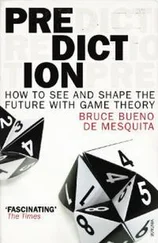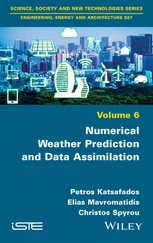Mark P. Kritzman - Prediction Revisited
Здесь есть возможность читать онлайн «Mark P. Kritzman - Prediction Revisited» — ознакомительный отрывок электронной книги совершенно бесплатно, а после прочтения отрывка купить полную версию. В некоторых случаях можно слушать аудио, скачать через торрент в формате fb2 и присутствует краткое содержание. Жанр: unrecognised, на английском языке. Описание произведения, (предисловие) а так же отзывы посетителей доступны на портале библиотеки ЛибКат.
- Название:Prediction Revisited
- Автор:
- Жанр:
- Год:неизвестен
- ISBN:нет данных
- Рейтинг книги:5 / 5. Голосов: 1
-
Избранное:Добавить в избранное
- Отзывы:
-
Ваша оценка:
- 100
- 1
- 2
- 3
- 4
- 5
Prediction Revisited: краткое содержание, описание и аннотация
Предлагаем к чтению аннотацию, описание, краткое содержание или предисловие (зависит от того, что написал сам автор книги «Prediction Revisited»). Если вы не нашли необходимую информацию о книге — напишите в комментариях, мы постараемся отыскать её.
Prediction Revisited: The Importance of Observation
Prediction Revisited also
Prediction Revisited
Prediction Revisited — читать онлайн ознакомительный отрывок
Ниже представлен текст книги, разбитый по страницам. Система сохранения места последней прочитанной страницы, позволяет с удобством читать онлайн бесплатно книгу «Prediction Revisited», без необходимости каждый раз заново искать на чём Вы остановились. Поставьте закладку, и сможете в любой момент перейти на страницу, на которой закончили чтение.
Интервал:
Закладка:
Table of Contents
1 Cover
2 Title Page PREDICTION REVISITED THE IMPORTANCE OF OBSERVATION MEGAN CZASONIS MARK KRITZMAN DAVID TURKINGTON
3 Copyright
4 Timeline of Innovations
5 Essential Concepts
6 Preface
7 1 Introduction Relevance Roadmap Note
8 2 Observing Information Observing Information Conceptually Observing Information Mathematically Observing Information Applied Appendix 2.1: On the Inflection Point of the Normal Distribution References Notes
9 3 Co-occurrence Co-occurrence Conceptually Co-occurrence Mathematically Co-occurrence Applied References Note
10 4 Relevance Relevance Conceptually Relevance Mathematically Relevance Applied Appendix 4.1: Predicting Binary Outcomes References Notes
11 5 Fit Fit Conceptually Fit Mathematically Fit Applied Notes
12 6 Reliability Reliability Conceptually Reliability Mathematically Reliability Applied References Notes
13 7 Toward Complexity Toward Complexity Conceptually Toward Complexity Mathematically Complexity Applied References
14 8 Foundations of Relevance Observations and Relevance: A Brief Review of the Main Insights Abraham de Moivre (1667–1754) Pierre-Simon Laplace (1749–1827) Carl Friedrich Gauss (1777–1853) Francis Galton (1822–1911) Karl Pearson (1857–1936) Ronald Fisher (1890–1962) Prasanta Chandra Mahalanobis (1893–1972) Claude Shannon (1916–2001) References Notes
15 Concluding Thoughts Perspective Insights Prescriptions
16 Index
17 End User License Agreement
List of Tables
1 Chapter 2Exhibit 2.5 DatasetExhibit 2.6 Arithmetic AveragesExhibit 2.9 Pairwise Spreads and Variance Calculation—Industrial Production...Exhibit 2.10 Conventional Variance Calculation—Industrial Production...Exhibit 2.11 Arithmetic Averages, Variances, and Standard DeviationsExhibit 2.12 Flipping 10 Coins
2 Chapter 3Exhibit 3.4 Correlation MatrixExhibit 3.6 Pairwise z-scores for Individual AttributesExhibit 3.7 Pairwise Co-occurrence—Industrial Production and Nonfarm Payrol...Exhibit 3.8 Information Distance of Pairwise Co-occurrence—Industrial Produ...Exhibit 3.9 Pairwise Correlation Calculation—Industrial Production and Nonf...Exhibit 3.11 Conventional Correlation Calculation—Industrial Production and...Exhibit 3.12 Correlation MatrixExhibit 3.13 Covariance Matrix
3 Chapter 4Exhibit 4.9 Observations and Their Relevance to  Exhibit 4.11 Relevance-Weighted Outcomes and Full-Sample Regression Predict...Exhibit 4.13 Conventional Full-Sample Regression PredictionExhibit 4.15 Partial Sample Prediction CalculationExhibit 4.16 Asymmetry Calculation for
Exhibit 4.11 Relevance-Weighted Outcomes and Full-Sample Regression Predict...Exhibit 4.13 Conventional Full-Sample Regression PredictionExhibit 4.15 Partial Sample Prediction CalculationExhibit 4.16 Asymmetry Calculation for  PredictionExhibit 4.17 Aggregate Asymmetry Calculation
PredictionExhibit 4.17 Aggregate Asymmetry Calculation
4 Chapter 5Exhibit 5.3 Pairwise Relevance and OutcomesExhibit 5.4 Prediction FitExhibit 5.5 Prediction Variance and BoundsExhibit 5.6 PrecisionExhibit 5.7 Calculating Prediction Fit for Partial Sample PredictionExhibit 5.8 Prediction Variance, Bounds, and Precision for Partial Sample P...
5 Chapter 6Exhibit 6.3 Calculating ReliabilityExhibit 6.4 Pairwise Relevance and Pairwise OutcomesExhibit 6.5 Pairwise Calculation of Full-Sample ReliabilityExhibit 6.6 Traditional Approach to Calculating R-squaredExhibit 6.7 Calculating Reliability for Partial Sample RegressionExhibit 6.9 Removing the Impact of Biased TermsExhibit 6.10 Addressing the Bias of R-Squared
6 Chapter 8Exhibit 8.1 Binomial Distribution
List of Illustrations
1 Chapter 2Exhibit 2.1 SpreadsExhibit 2.2 Triangle of PairsExhibit 2.3 Subsequent GDP GrowthExhibit 2.4 Trailing Percentage Changes in Industrial ProductionExhibit 2.7 Industrial ProductionExhibit 2.8 Histogram of Industrial ProductionExhibit 2.13 Distribution of CombinationsExhibit 2.14 Counting Distinct Combinations for 30 Trials
2 Chapter 3Exhibit 3.1 Two Positively Related Attributes for a Single ObservationExhibit 3.2 Possible Co-occurrence Patterns for Attributes with a Given Aver...Exhibit 3.3 Co-occurrence for Single ObservationsExhibit 3.5 Pairs of Pairs Approach for Estimating Co-occurrenceExhibit 3.10 Pairwise Co-occurrence—Industrial Production and Nonfarm Payrol...
3 Chapter 4Exhibit 4.1 Scatter Plot of Two Hypothetical AttributesExhibit 4.2 Similarity, Informativeness, and Relevance of Hypothetical Obser...Exhibit 4.3 Simulated Symmetric RelationshipExhibit 4.4 Predictions versus Actual OutcomesExhibit 4.5 Simulated Asymmetric RelationshipExhibit 4.6 Predictions versus Actual OutcomesExhibit 4.7 Informativeness and Similarity with Two AttributesExhibit 4.8 Equally Informative Observations with Five AttributesExhibit 4.10 Relevance of Observations to  Exhibit 4.12 Outcome Deviations from AverageExhibit 4.14 Relevance and Outcome Deviations—25% Most Relevant Observations...Exhibit 4.18 AsymmetryExhibit 4.19 Logistic FunctionExhibit 4.20 Logit Function (inverse of the logistic function)
Exhibit 4.12 Outcome Deviations from AverageExhibit 4.14 Relevance and Outcome Deviations—25% Most Relevant Observations...Exhibit 4.18 AsymmetryExhibit 4.19 Logistic FunctionExhibit 4.20 Logit Function (inverse of the logistic function)
4 Chapter 5Exhibit 5.1 Relevance and Outcomes for a Very Good Partial FitExhibit 5.2 Pairwise Relevance and Fit
5 Chapter 6Exhibit 6.1 Components of Fit for Simulated Random NoiseExhibit 6.2 Components of Fit for Simulated Random NoiseExhibit 6.8 Reliability of Partial Sample Regression
6 Chapter 7Exhibit 7.1 Decision Tree
7 Chapter 8Exhibit 8.2 Galton's Quincunx
Guide
1 Cover
2 Table of Contents
3 Title Page
4 Copyright
5 Timeline of Innovations
6 Essential Concepts
7 Preface
8 Begin Reading
9 Concluding Thoughts
10 Index
11 End User License Agreement
Pages
1 iii
2 iv
3 ix
4 xi
5 xii
6 xiii
7 xiv
8 xv
9 xvi
10 xvii
11 1
12 2
13 3
14 4
15 5
16 7
17 8
18 9
19 10
20 11
21 12
22 13
23 14
24 15
25 16
26 17
27 18
28 19
29 20
30 21
31 22
32 23
33 24
34 25
35 26
36 27
37 28
38 29
39 30
40 31
41 32
42 33
43 34
44 35
45 36
46 37
47 38
48 39
49 41
50 42
51 43
52 44
53 45
54 46
55 47
56 48
57 49
58 50
59 51
60 52
61 53
62 54
63 55
64 56
65 57
66 58
67 59
68 60
69 61
70 62
71 63
72 64
73 65
74 66
75 67
76 68
77 69
78 70
79 71
80 72
81 73
82 74
83 75
84 76
85 77
86 78
87 79
88 80
89 81
90 82
91 83
92 84
93 85
94 86
95 87
96 88
97 89
98 90
99 91
100 92
101 93
102 94
103 95
104 96
105 97
106 98
107 99
108 100
109 101
110 102
111 103
112 104
113 105
114 106
115 107
116 108
117 109
118 110
119 111
120 112
121 113
122 114
123 115
124 116
125 117
126 118
127 119
128 120
129 121
130 123
131 124
132 125
133 126
134 127
135 128
136 129
137 130
138 131
139 132
Читать дальшеИнтервал:
Закладка:
Похожие книги на «Prediction Revisited»
Представляем Вашему вниманию похожие книги на «Prediction Revisited» списком для выбора. Мы отобрали схожую по названию и смыслу литературу в надежде предоставить читателям больше вариантов отыскать новые, интересные, ещё непрочитанные произведения.
Обсуждение, отзывы о книге «Prediction Revisited» и просто собственные мнения читателей. Оставьте ваши комментарии, напишите, что Вы думаете о произведении, его смысле или главных героях. Укажите что конкретно понравилось, а что нет, и почему Вы так считаете.












